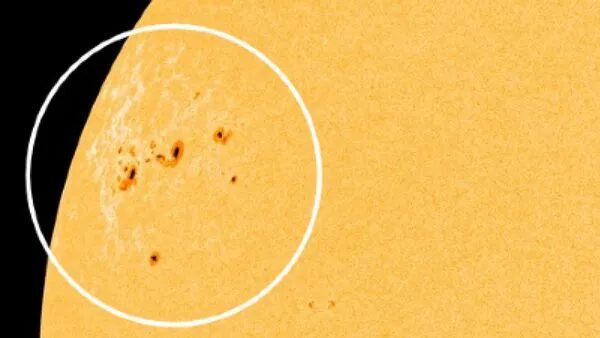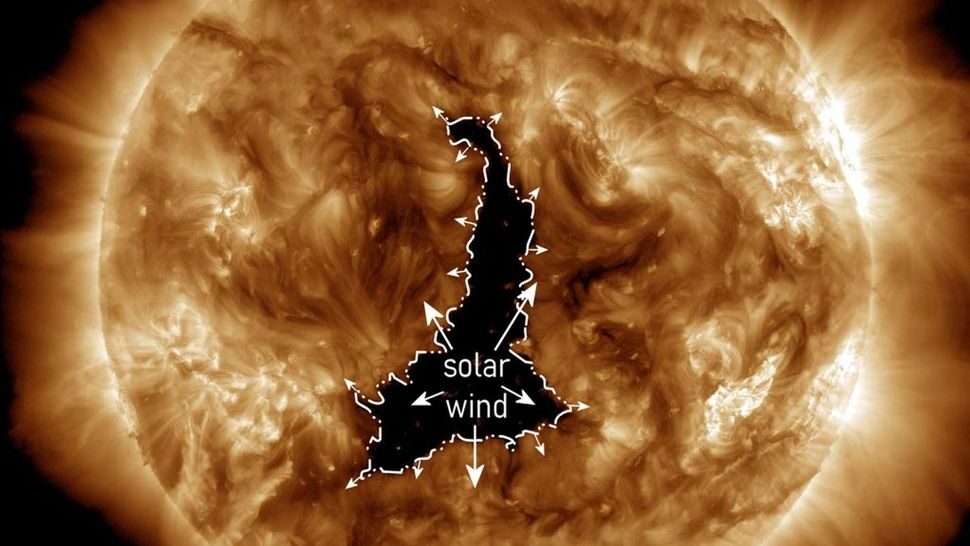The sun has produced a massive coronal hole and is "spewing a stream of solar wind directly toward Earth," according to Spaceweather.com.
An enormous dark hole has opened up in the sun's surface and is spewing powerful streams of unusually fast radiation, known as solar wind, right at Earth. The size and orientation of the temporary gap, which is wider than 60 Earths, is unprecedented at this stage of the solar cycle, scientists say.
The giant dark patch on the sun, known as a coronal hole, took shape near the sun's equator on Dec. 2 and reached its maximum width of around 497,000 miles (800,000 kilometers) within 24 hours, Spaceweather.com reported. Since Dec. 4, the solar void has been pointing directly at Earth.
Experts initially predicted this most recent hole could spark a moderate (G2) geomagnetic storm, which could trigger radio blackouts and strong auroral displays for the next few days. However, the solar wind has been less intense than expected, so the resulting storm has only been weak (G1) so far, according to Spaceweather.com. But auroras are still possible at high latitudes.
It is unclear how long the hole will remain in the sun, but previous coronal holes have lasted for more than a single solar rotation (27 days) in the past, according to NOAA. However, the hole will soon rotate away from Earth.
Coronal holes occur when the magnetic fields that hold the sun in place suddenly open up, causing the contents of the sun's upper surface to stream away in the form of solar wind, according to the National Oceanic and Atmospheric Administration (NOAA). Coronal holes appear as dark patches because they are cooler and less dense than the surrounding plasma. This is similar to why sunspots appear to be black — but unlike sunspots, coronal holes are not visible unless they are viewed in ultraviolet light.
The radiation streams from coronal holes are much faster than normal solar wind and often trigger disturbances in Earth's magnetic shield, known as geomagnetic storms, according to NOAA. The last coronal hole to appear on the sun, which emerged in March, spat out the most powerful geomagnetic storm to hit Earth in more than six years.
Solar activity has been ramping up all year as the sun nears the explosive peak in its roughly 11-year solar cycle, known as the solar maximum. However, in a bizarre twist, the gigantic new coronal hole is not supposed to be part of this increase in solar activity.
Coronal holes can occur at any point throughout the solar cycle, but they are actually more common during solar minimum, according to NOAA. When they do emerge during solar maximum, they are normally located near the sun's poles and not near the equator. It is, therefore, a mystery how such a massive hole opened up near the equator when we are so close to the solar maximum.
However, over the last few weeks, there have been numerous other signs that the sun is getting more active.


Harry Baker is a U.K.-based staff writer at Live Science. He studied Marine Biology at the University of Exeter (Penryn campus) and after graduating started his own blog site "Marine Madness," which he continues to run with other ocean enthusiasts. He is also interested in evolution, climate change, robots, space exploration, environmental conservation and anything that's been fossilized.




Reader Comments
I have been taking NAC for 3-4 years and have not had the mRNA poison jab. This is a sign that I need to take care of some other things regarding my health sooner than later.
❤
2-3/daily COD Liver Oil
NO running❣️❣️ Walk in Sun n breathe down to the 👣👣👣👣SAUERKRAUT, salt-based!!
1 daily cup + 1 daily 🍎 1st month add small garlic toe, chewed or swallowed.
PH Balance is KEY to perfect HEALTH; GUT 'clean-out' clears anything n all UP⬆️
DIY LactoFermentation 101
[Link]
And daily warm-up
[Link]
5 or 6 RITES
[Link]
NOW as you said.... GET ON WITH IT!! cause back-up planets ARE lined up. Pay better attention than RC HV Speedz ls strategery..... et alllll I's serious.
I take a daily tizane/powdered herb blend that includes turmeric(anti-inflammatory properties) which attributed, imo, to my last mild reaction to a wasp sting ( compared to a prior reaction prior to daily drinking this blend )
I think it's been show through a study in india as well, can't find the particular study: here's general search results: [Link]
My understanding is that the heavy-metal-removal-qualities of natto require simultaneous detox with some sort of EDTA Chelation - we use green algae pills...
unrelated but open to ideas - my eyes crossed almost two years ago - spontaneously - I've tried passive methods, including getting glasses that I can't bear wearing - and have some exercises when I feel like getting more serious solving this confusing state..
Suspicious0bservers is good at explaining it and he does space weather news every morning and does longer explainers for various types of activity on the sun, though he's also considered controversial for the insistence that a micro-nova is coming. On the other hand, just 2 years ago, scientists would not admit that micro-novae were even a thing. Now they are a fact. [Link]
[Link]